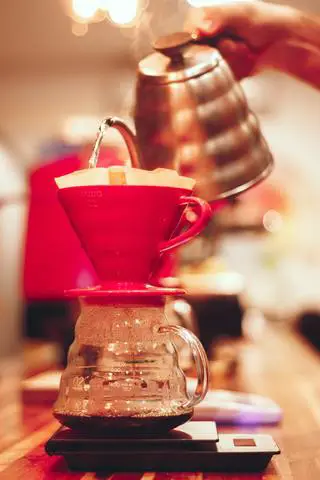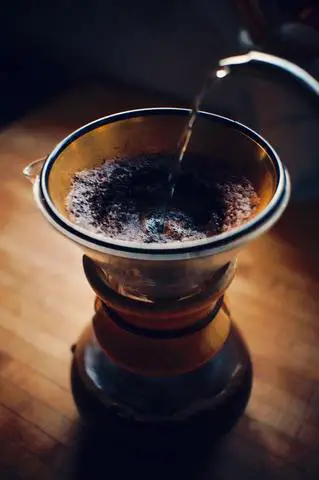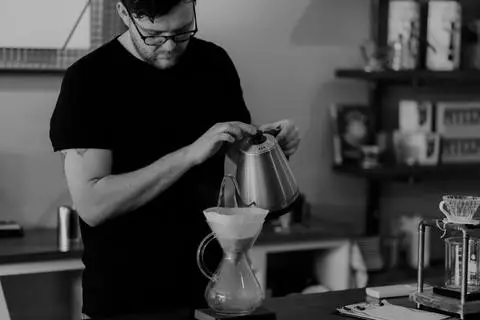One of the most popular brewing methods today in third wave cafes is the pour over; a by-hand brewing method that seeks to improve upon the brewing process of a typical drip brewer. A pour over setup requires at least four components in addition to the ground coffee and water: a pour over cone, a mug, a paper filter (or a steel mesh filter), and a gooseneck kettle, which has the advantage of more precisely pouring water as compared to a standard kettle. In addition, a scale is heavily recommended, as it helps guarantee consistent measurements.
This guide will cover a few different pour over techniques you may want to avoid, as they often achieve less than satisfactory results. We will then note one technique that yields fantastic coffee every time. For each method, we will be using 25 grams of ground coffee, a paper filter, and 400 grams of 200 degree Fahrenheit (93 C) water.

Setup
As an initial step, always pre-moisten the paper filter. To do this, simply pour enough water hot water through the filter until it is wet and dispose of the excess water; this does away with any possibility of a papery flavor being imparted on the coffee.
Next, you need to grind and weigh the coffee. After that, place your mug with the pour over and filter (with the level grounds) on top of it, on the scale and zero it out. You want the scale zeroed, because then it will be easier to tell when you pour the optimum amount of water through.
Blooming the coffee before pouring the water through the filter is essential. To do this, simply pour an amount of water small enough to evenly saturate the grounds – about 50 grams or so – and let it rest for 15-30 seconds. You will notice that a crust forms; this step helps ensure that the ground coffee is well prepared for brewing by releasing natural gasses trapped in the grounds, making brewing smoother. The tip of the gooseneck kettle should be as close to the bed of coffee as possible without touching, as pouring from too high up will agitate the grounds too much, leading to bitterness. There is some debate as to if you should put a little divot in the bed of grounds before starting. I personally do, because it helps the bloom water penetrate deeper, but it largely amounts to personal preference.
Now, let’s examine three different pouring techniques and the results you might expect from each.
Technique #1: The “All In” Pour

This method, often used by pour over novices, is the most straight-forward of the three, but tends to yield comparatively poor results. Essentially this method involves quickly pouring all of you water in at once. This technique is bad for a few reasons, but the primary one is that no water comes in contact some of the grounds and too much water contacts others. This results in the same water extracting the same grounds, and eventually, over extraction. However, this also results in a cascading ring of under extracted coffee grounds in the cone. This uneven extraction leads to a bitter, unpleasant taste.
Technique #2: The Straight Pour

After wetting the filter and allowing the coffee grounds to bloom, The Straight Pour technique consists of slowly moving the tip of the kettle around the crust, aiming for the dark spots, until the scale says you hit 400 grams of water.
While this may seem intuitive for the inexperienced, failing to allow the grounds any rest period means that the water will stay in the cone longer than necessary, leading to a very uneven extraction. Additionally, you can very easily use all of your water prematurely, leaving a ring of ground coffee around the inside of the filter, and causing the still submerged grounds to over extract.
The Straight Pour, while an improvement over the “All in” pour, is still less than ideal. While this method essentially mirrors what many drip coffee makers do, it leaves the true potential of pour over on the table of being able to produce an ideal extraction.
Technique #3: A Proper Pour

One way to correctly brew coffee with a pour over is to do three total passes with the water. To start, moisten the filter, and bloom the coffee. Next, do one pour consisting of about 100 grams of water into the filter. However, don’t pour the water all in one spot; move in slow, concentric circles while keeping most of the water flow towards the center where the bed of grounds is the deepest. After pouring the water, let most of it pass through (which will take roughly 15 or so seconds), and then repeat this process until you run out of water, which will happen after two more pours. On each pour, start on the outside to bring in all the grounds, and try to focus the water on the darker spots where the grounds are concentrated.
This method can be altered depending on the amount of coffee you are looking to make, or the flavor you’re going for. It is totally possible to do more than three pours, and a lot of baristas swear that more pours means better coffee; however, this largely comes down to personal preference. If you are making a larger quantity of coffee at once, doing more than three or four pours may be necessary, as there won’t be as much spare room for water in the cone.
After all the water has passed through the filter, there are two things you should look for:
1) an uneven bed of coffee, and
2) volcano sides.
An uneven bed of coffee means that the water was poured unevenly. “Volcano sides” refers to the grounds moving away from the center and accumulating along the sides and means that the inner sides of the pour over were neglected while pouring. Both of these indicate potential over or under extraction.
If you notice that your pour over has become clogged and won’t drain, try pouring from slightly higher up, as this should agitate the grounds just enough to clear a blockage. However, if this happens frequently, grinding the coffee slightly more coarsely can help prevent blockages from occurring.
Hopefully you picked up on a few tips here. With a bit of practice, you’ll be a pour over master in no time!
